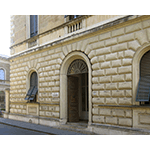Museo di Anatomia e Istologia Patologica dell'Universitą degli Studi di Pisa [University of Pisa Museum of Anatomy and Pathological Histology]
The Museum, an integral part of the Medical School, originated in 1870 as a collection of anatomical-pathological parts, to be used in teaching and research. It contains around 1,500 prepared anatomical specimens (both dry and wet) and is continuously incremented with parts that are rare or of special medical interest acquired during autopsies.
Particularly interesting among the nineteenth-century collections, are the series of gallstones, consisting of around 50 pieces, and of neonatal malformations, with 25 pieces covering almost all types of congenital malformation. Also dating from the 19th century is the animal teratology collection which contains, among its various pieces, a dog with six legs, a cat with two heads and a baby chick with two heads and four legs. Recently, for the study of occupational diseases, a collection of lungs has been formed, coming from autopsies performed on workers in marble quarries, in the metallurgical sector and in glassware factories. The museum also has around 30,000 reports of autopsies performed from 1884 to the present.
The historic library annexed to the museum possesses a valuable collection of prints on pathological anatomy and about 6,000 volumes, among them two editions of Jean Cruveilhier (1845) and the original miscellanies of Angiolo Maffucci and Antonio Caesaris Demel.
****************************
Texts by Graziano Magrini
English translation by Catherine Frost
Last update 23/feb/2008




